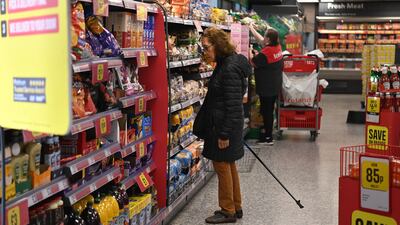Double and triple checking of food receipts has become a common sight in UK supermarkets in recent times, and data released by Britain's Office for National Statistics on Tuesday explains the incredulity.
Compounding the country's growing cost-of-living crisis, the prices of some of the cheapest food types have shot up by up to two thirds over the last year, plotting a grim inflationary path.
The price of the least expensive pasta that under-pressure shoppers can get has risen by 60 per cent in the last year.
The cheapest vegetable oil on supermarket shelves has jumped by 65 per cent.
Statisticians have collected more than a million prices from supermarket websites since September last year to compare the cost of the cheapest available produce, allowing them to better understand the impact of the cost-of-living crisis on poorer households.
They said that the cheapest tea had risen in price by 46 per cent, chips rose 39 per cent, bread was up 38 per cent and biscuits up 34 per cent.
Some items bucked the trend, with orange juice dropping 9 per cent, and minced beef 7 per cent.
However, with a 17.3 per cent increase in all food items, the overall link between grocery prices and inflation is clear.
That clarification follows British food campaigner Jack Monroe's criticism of the ONS system for measuring the impact of inflation. She said in January that it was “fundamentally flawed” and “completely ignores the reality”.
In response, the ONS changed its calculus to produce the latest data.
“While the recent spike in inflation began with energy prices, today's fresh insights using a new innovative data source show they are now filtering through to other important items, with the cheapest price of some staple food items rising by around two thirds in the last year,” said ONS statistician Sir Ian Diamond.
Cost-of-living crisis brought out of the abstract
In a complementary release, the ONS published separate data on the socio-demographic trends underlying the cost-of-living crisis, which unsurprisingly showed the squeeze hitting the poorest in society hardest.
Comparing the period between March and June this year to July and September, the survey found 72 per cent of people with prepayment energy meters are finding it difficult to pay their bills.
It also found that seven in 10 black adults and more than half of disabled adults are finding it difficult to afford their energy bills, compared to just 44 per cent of white adults.
People across the UK are also finding it harder to pay their mortgages and rents, with the latter cohort struggling the most.
About six in 10 (60%) renters reported finding it difficult to afford their energy bills, compared with about four in 10 (43%) of those with a mortgage.
Around a third (35%) of those who owned their home outright reported finding it difficult to afford their energy bills.
The data also laid bare regional inequalities. With property prices at their highest in London, the survey found its residents were finding it hardest to pay their mortgages and rent when compared with elsewhere in the country.
“Figures from our near real-time survey of people show that while rises in food and energy costs are affecting many people across the country, those who are disabled, from certain ethnic minority backgrounds and renters are among those struggling the most,” Sir Ian said.
“With rises in the cost of living at the forefront of many people's minds, our new, almost real time, data showing just how prices are changing and shining a light on how different groups are affected have never been more important.”

